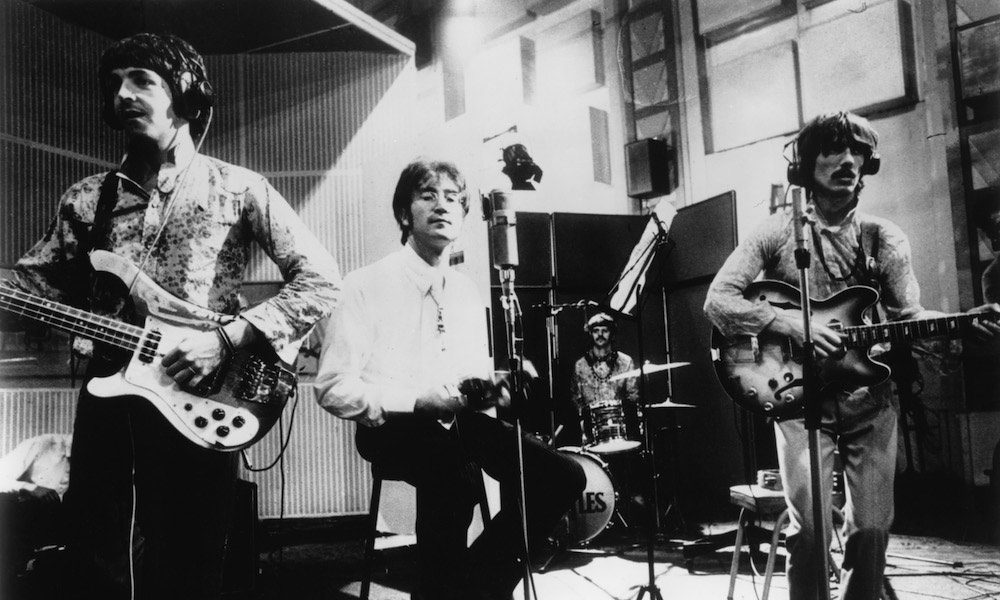‘Yer Blues’: The Story Behind The Song
As dark and heavy as any song in The Beatles’ canon, ‘Yer Blues’ demanded an intensity to match – and found it in a cramped Abbey Road storage room.

“While we were recording The White Album, we ended up being more of a band again,” Ringo Starr would reflect, “and that’s what I always love. I love being in a band.” Increasingly over the previous few albums, The Beatles’ recordings had been crafted, layer upon layer of sound painstakingly assembled, rather than performed live in the studio as their earliest records had been. But for The White Album, they consciously set out to return to playing the songs as a band, getting closer and closer musically – and, in the case of John Lennon’s “Yer Blues,” physically.
By their own admission, The Beatles had started out playing heavy rock. “But when it was put down on the early records, there was never enough bass in it, the guitar solo never came through, because we didn’t know about recording then,” John explained shortly after The White Album’s release. “We sounded more like us on this record. We rid ourselves of the self-consciousness bit, so we were doing what we were doing earlier on, but with a better knowledge of the technique of recording. Quite a few of the tracks are just straight takes of us playing.”
Writing the song
“Yer Blues” is one of the many White Album songs written in India in spring 1968. And while their stay there was an exercise in serenity for many, John was going through something of personal crisis. His marriage to Cynthia was drawing to a close, and his relationship with Yoko Ono was just on the cusp: “The funny thing about the camp was that although it was very beautiful and I was meditating about eight hours a day, I was writing the most miserable songs on earth. In ‘Yer Blues,’ when I wrote, ‘I’m so lonely I want to die,’ I’m not kidding. That’s how I felt. Up there trying to reach God and feeling suicidal.”
The Esher demo of “Yer Blues,” recorded shortly after The Beatles all regrouped back in England, offers no warning of the ferociousness that would overtake the song by the time it was complete, with acoustic guitars playing traditional blues licks.
Stylistically, “Yer Blues” could be seen as either a nod to, or a parody of, the current boom of heavy blues bands, such as Cream, Big Brother And The Holding Company, and Canned Heat. John’s clever lyrical twists, however, lifted it well beyond pastiche. For example, rather than use the old blues cliché “Black cat crossed my path,” John sang, “Black cloud crossed my mind,” continuing, “Blue mist round my soul/Feel so suicidal/Even hate my rock’n’roll.” This was as dark and heavy a song as any in The Beatles’ catalogue, and demanded an intensity of performance to match.
The recording
Engineer Ken Scott recalls how, during a session for the then-unreleased George Harrison song “Not Guilty,” he joked with John about how The Beatles were always trying to find new ways to affect their sound: “Originally with EMI they only had two four-tracks. These particular four-tracks were really large, so they kept them in two small rooms, both next door to Number Two control room… So I stood up next to John, and as a joke, I said, ‘God, the way you guys are going, you’re gonna want to record in there now,’ pointing to one of these two rooms. John just sort of looked over there and didn’t say anything. A little later on we were gonna start a new song called ‘Yer Blues’, and John turns around and says, ‘I wanna record it in there,’ and he points to the room I’d been joking about. We had to fit them into this ridiculously small room. If one of them had suddenly swung his guitar around, he would’ve hit someone in the head.”
Capturing the song across September 13, 14, and 20 1968, The Beatles hoped that playing in such a confined space would help recreate the feel of the stage at the Cavern in Liverpool. “We liked being in close contact with each other,” said Paul. “We felt it added to the power of our music, and it did.”
And how. Scott was surprised by how much separation they managed to achieve in such a cramped space, simply by turning the amplifiers to face the wall. Paul’s bass is throbbing and heavy, Ringo’s drums sound as meaty as anywhere on the album, the guitars howl on the verge of feeding back, and John’s vocal is as torn up as any of his wildest rock’n’roll performances. So pleased with the outcome was John that it was one of two numbers he performed with The Dirty Mac at The Rolling Stones’ Rock’n’Roll Circus in December, playing it again in September 1969 at the Toronto Rock And Roll Revival festival.
The super deluxe edition of The Beatles’ White Album can be bought here.













Laura Salovitch
May 13, 2021 at 10:43 pm
Fantastic song.